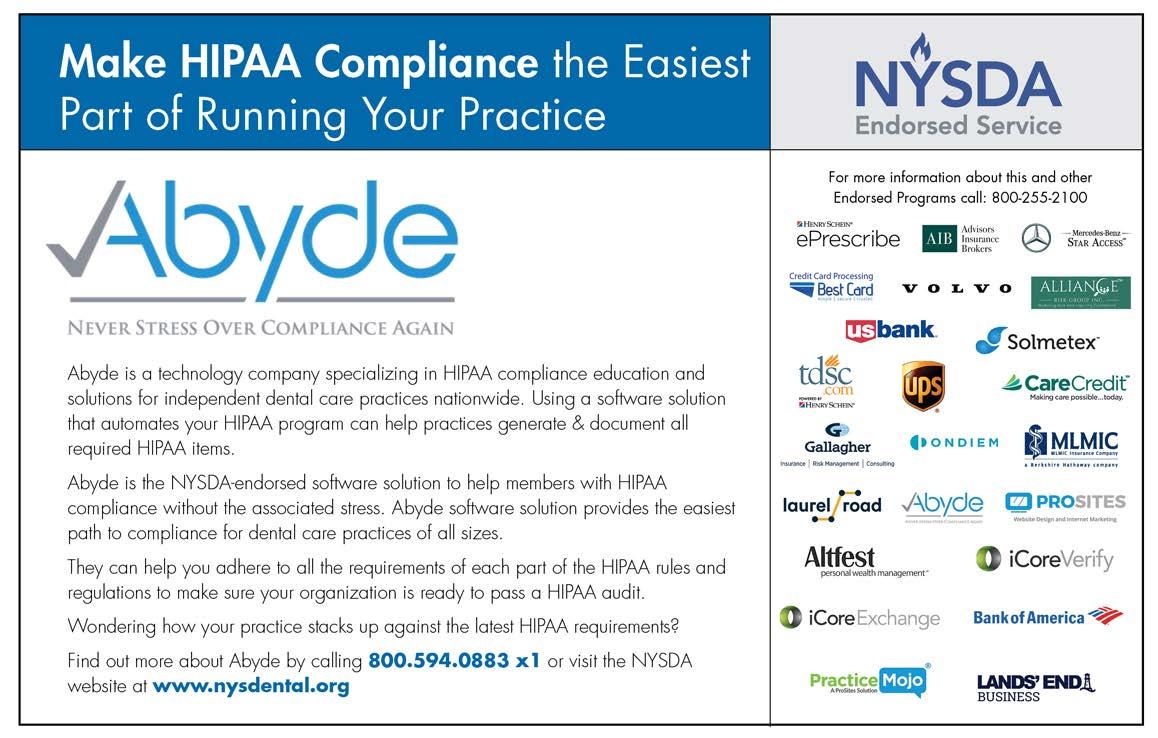
13 minute read
Challenges and Implications of Mandated Reporting to Child Welfare in Dentistry
Challenges and Implications of Mandated Reporting to Child Welfare in Dentistry
Katheryn Goldman, D.M.D., M.P.H., Ph.D.; Daniel Pollack, M.S.W., J.D.
ABSTRACT
Dentists are mandated reporters and at the forefront of screening for child welfare referrals. The laws and systems surrounding reporting practice leave dentists working in pediatric settings with the responsibility for making a quick judgment about child maltreatment, with limited information and, sometimes, limited training. Increased interdisciplinary collaboration and education are necessary to better prepare and support dentists for interaction with children who may present with suspected child maltreatment.
It is estimated that in 2021, there were 600,000 victims of child abuse and neglect.[13] The victim rate for child maltreatment is 8.1 victims per 1,000 children in the population.[13] In 2021, it is estimated that nationally 1,820 children died from child maltreatment, at a rate of 2.46 per 100,000 children in the population.[13] Research has found high substantiation rates among reports made by medical staff.[6]
Every state includes dentists as mandated reporters of suspected child maltreatment; however, each state has its own laws on reporting and reporting requirements.[9] States use wording similar to the federal definitions of child maltreatment, with all state statutes covering situations where the reporter has observed evidence of harm as reasonable cause to suspect child maltreatment.[7,9] However, some states also invoke a mandate to make a child maltreatment report based on a judgment of future harm, even if there is no current observation of injury. [9,10]
Human judgment does not occur in a vacuum and is subject to bias and misinterpretation of definitions of child maltreatment. Nonetheless, federal child welfare law does not have specific requirements to ensure that mandated reporters understand their role or what specifically constitutes child maltreatment.[9] Thus, state definitions of child maltreatment, reporting practices, as well associated training, are subject to substantial variation.[9] Therefore, one can see the challenge of ensuring that dentists understand their roles as mandated reporters and are prepared to appropriately identify instances of child maltreatment.
Background
The Federal Child Abuse Prevention and Treatment Act (CAPTA) mandates that states have procedures for requiring certain individuals to report known or suspected instances of child abuse and neglect. Across many scopes of dental practice, dentists have significant interactions with pediatric patients and are at the forefront of identifying cases of child maltreatment.
The laws and systems surrounding reporting practice leave dentists with the responsibility of making quick judgments about child maltreatment, often with limited information. Furthermore, states do very little to ensure that as mandatory reporters, dentists are adequately trained on when or when not to suspect child maltreatment.[9]

Practice Implications
While physical abuse may often be clinically obvious, many situations of suspected child maltreatment are more nuanced and require a strong understanding of what legally and clinically constitutes child maltreatment to avoid inappropriately filing a report or deferring to file.
For example, a new dental graduate who is informed by the hygienist that a 5-year-old girl has presented to the appointment wearing “dirty clothes” with “unkempt hygiene,” is the child being neglected, or is the family struggling with issues related to poverty?
A general definition of neglect is offered by the Centers for Disease Control and Prevention (CDC): “Neglect is the failure to meet a child’s basic physical and emotional needs. These needs include housing, food, clothing, education, access to medical care, and having feelings validated and appropriately responded to.” There is a stark difference between poverty and intent to neglect.
The dentist is told by her supervisor to make a report. If you see something, say something. Right? It’s not so clear. If the individual reporter fails to report suspected child maltreatment and an adverse event occurs, not only does the moral consequence and guilt of personal negligence resulting in injury to a child weigh heavily on the individual, so does a potential legal consequence. This may include loss of licensure, which an individual may have worked years to obtain.
If that same individual does make a report, he or she is potentially bringing duress and trauma upon a family for an uncertain cause. There may be a loss of rapport with the family that could further harm the child by isolating the child from resources and services. There is also fear of potential retaliation towards the individual reporter.
Clearly, the system is structured in such a way that it unconsciously coaxes individual reporters to consider their own interests in a scenario where the focus should be directed solely towards the needs of the child. Simply put, in the current legal scheme, the twin desires of worker self preservation and child safety are often at odds. We place the burden of the outcome of a potential child maltreatment report/failure to report on the individual dentist. Unwittingly, this makes it much easier to demonize the individual worker.
Unfortunately, misguided decision-making happens. Individuals’ personal beliefs and biases surrounding gender, socioeconomic status, race and family structure have the potential to weigh heavily on their decision-making process to report. For example, a recent study conducted by Hymel et al.[14] noted that children from diverse racial and ethnic backgrounds with head injuries were twice as likely to be reported for abusive head trauma compared to white children with similar symptoms.[3]
Absent clinical difference, the individual biases of medical professionals can have significant consequences on families. Racial and socioeconomic disparities in child welfare referrals have been well-documented within the literature and have also posited to be perpetuated by the human decision-making of mandated reporters and other individual decision-makers along the child-welfare referral process who are not subject to peer or committee review.[3] In reality, mandated reporters are specifically instructed that they must only have a “reasonable suspicion” to make a report. However, in instances of suspected neglect, this can be highly problematic.
Here is another example: A child continuously reports to the pediatric dental office for a recurrent abscess on tooth #30. The office has on multiple occasions referred the family to an endodontist for evaluation. The mother says, “She is doing her best.” The mother feels that she is sufficiently providing her child care through the emergency visits. The dentist reports the family to child protective services for not following through with necessary care.
The back story that was not obtained before this report was filed was that the only endodontist is located 75 miles from the family’s home. The family has only one car, which is used by the sole household earner. The earner works a job where the management is inflexible and routinely denies requests for time off due to “understaffing.” Obtaining this information from the family prior to the referral would have clarified the barriers to care and would have eliminated an unnecessarily traumatic experience with CPS involvement. The mother in this scenario is not unwilling to seek care for her child. She needs assistance navigating the barriers to her child’s care.
In many dental settings, there is not always an available worker to help families navigate these barriers, which are often exacerbated by poverty, not bad intent. In these instances, mandated reporters incorrectly assume that they can rely on CPS as a means of connecting families to support. While the social services system should function in a way that supports families and does not criminalize poverty, well-intended individuals may make reports not understanding that in some states, an investigation of the family is the only option. Research has found that 7% of children in low-poverty neighborhoods experience a substantiated CPS investigation at some point in childhood using the 2014 and 2015 rates—this risk almost doubled for children in moderate-poverty neighborhoods and was more than triple for high-poverty neighborhoods.[5]
Research also suggests that government programs that reduce poverty, particularly for working parents, may also reduce some forms of CPS involvement.[12] Malintent in the case of child neglect is hard to substantiate and should never be conflated with situational poverty. Limited economic resources may directly affect parental investments in food, clothing, medical care, education, safe and stable housing and childcare arrangements, which could be observationally misconstrued as neglect.[11] Therefore, families who are identified by dentists as having social needs that put the family at risk for child neglect should be referred to internal or external social resources/programming, with follow-up to ensure that the child’s unmet social needs are being met.
If follow-up identifies families who are unwilling to provide for the child after appropriate support and material needs have been supplied, child neglect would then need to be considered. This clinical pathway of action would provide support to families who are struggling and desire to support the child, arguably, the majority of families, and would limit unnecessary interface with child welfare.
In reacting to poverty-driven referrals, some states have adopted an alternative response that is applied to low-to-moderate risk cases and involves parents identifying their own individual needs in order to facilitate family engagement with services. This differs from investigating all reports and does not typically require a formal determination of child abuse or neglect or the entry of names into a central registry.[4]
The adaptation of the alternative response allows for families who are struggling with issues of poverty to connect with resources. Ideally, this connection would be made outside of a child welfare setting and points to the strong need for pediatric healthcare practices in community settings to be given tools and resources to provide direction and help to struggling families without utilizing CPS as an interface.
Educating Dentists
The substation rate of all referrals to child welfare in the United States is 15.92%.[8] This means that the majority of cases do not qualify as child maltreatment or do not have sufficient evidence to demonstrate that child maltreatment occurred. While often no harm is done by being overly cautious, in reality, interaction with child protective services is traumatic for families, particularly in communities that have a pervasive, historic relationship with child welfare. This data also calls into question the effectiveness of the mandated reporting system as a whole, and demonstrates a strong need to better educate professionals, including dentists, on how to identify cases of child maltreatment.
Increased interdisciplinary training that includes legal and social work professionals who work within child advocacy systems should be considered at state and institutional levels to support dentists in practice. In many workplace settings, particularly those that are under-resourced, dentists do not have an available staff person to seek counsel or advice before making a child welfare referral.
Other remedial steps are:
• Include more in-depth interdisciplinary education during dental school to teach how the child welfare system works. Often, education covers the clinical aspects of child maltreatment, as well as the legal obligation of the mandated reporter, but it does not include how the child welfare systems actually work. Leaving out this key structural piece makes it so that healthcare providers such as dentists can rely on child protective services to provide resources for a family. While some states have adopted this approach, this is not the case in every state. Dentists must be aware that they may be inadvertently launching an investigation of a family they are trying to connect to help.
• Increase and improve licensure training on mandated reporting. Often, child maltreatment training is limited to a required course for professional licensure that does not adequately prepare dental professionals for the realities of mandated reporting in practice. Increased training would particularly benefit new dentists who may not have the practice experience to guide decision-making. The scenarios in these trainings are often very clearly child maltreatment and do not delve into how to handle scenarios that may fall into a less clear-cut action plan.
Conclusion
Ultimately, the question of whether to file a child abuse/ neglect report is a legal decision. Unfortunately, dentists acting as mandated reporters, though making a legal decision, may have limited familiarity with the nuances of laws surrounding what constitutes abuse and neglect. And so, regrettably, a child may suffer due to the reporter’s ignorance or inexperience.
While there are many flaws within the child welfare system, improving practice through the interfaces of the many professions that interact with it, such as dentistry, can be a means of reducing unnecessary interactions between families and child welfare professionals and ensuring that true cases of child maltreatment are referred to child protective services.p
The authors report no financial contributions or conflicts of interest to disclose. Queries about this article can be sent to Dr. Goldman at kgoldma2@mail.yuy.edu.
REFERENCES
1. Child Abuse Prevention and Treatment Act. 42 U.S.C. § 5106a(b)(2)(B)(i).
2. Centers for Disease Control and Prevention. (2022, April 6). Fast facts: Preventing child abuse & neglect |violence prevention |injury. https://www.cdc.gov/violenceprevention/ childabuseandneglect/fastfact.html
3. Child Welfare Information Gateway. (2021). Child welfare practice to address racial disproportionality and disparity. U.S. Department of Health and Human Services, Administration for Children and Families, Children’s Bureau. https://www.childwelfare.gov/pubs/issuebriefs/racial-disproportionality/.
4. Child Welfare Information Gateway. (2020). Differential response: A primer for child welfare professionals. Washington, DC: U.S. Department of Health and Human Services, Children’s Bureau.
5. Fong K. Neighborhood inequality in the prevalence of reported and substantiated child maltreatment. Child Abuse & Neglect 2019;90, 13-21.
6. Kesner JE. Dever BV. An inter-reporter analysis of mandated child maltreatment reporting in the USA. Mandatory reporting laws and the identification of severe child abuse and neglect 2015;61-75.
7. Levi BH, Portwood SG. Reasonable suspicion of child abuse: Finding a common language. Journal of Law, Medicine and Ethics 2011;39(1), 62–68. Crossref PubMed. ISI.
8. Mathews B, Bross DC. Mandated reporting is still a policy with reason: Empirical evidence and philosophical grounds. Child Abuse & Neglect 2008;32(5), 511-516.
9. Mudrick NR., Blackwell J., Watts C, Smith CJ, Williams A, Nielsen K A, Clark L. (2022). How do states inform nurses of their policies for mandatory reporting of child maltreatment? Policy, Politics, & Nursing Practice 2022;23(2):109-117.
10. Mudrick NR, Smith CJ. Commentary: Mandatory reporting for child protection in health settings and the rights of parents with disabilities. Disability and Health Journal 2017;10(2):165–168. Crossref PubMed.
11. Pac J, Collyer S, Berger L, O’Brien K, Parker E, Pecora P, Wimer C. The effects of child poverty reductions on child protective services involvement. Social Service Review 2023;97(1):43-91.
12. Raissian KM, Bullinger LR. Money matters: Does the minimum wage affect child maltreatment rates? Children and Youth Services Review 2017; 72:60-70.
13. U.S. Department of Health & Human Services, Administration for Children and Families, Administration on Children, Youth and Families, Children’s Bureau. (2023). Child Maltreatment 2021. Available from https://www.acf.hhs.gov/cb/data-research/child-maltreatment.
14. Hymel KP, Laskey AL, Crowell KR, Wang M, Armijo-Garcia V, Frazier TN, Karst WA. Racial and ethnic disparities and bias in the evaluation and reporting of abusive head trauma. Journal Pediatrics 2028;198:137-143.

Katheryn Goldman, D.M.D., M.P.H., Ph.D., is a practicing pediatric dentist in a children’s hospital. She is a graduate of University of Pennsylvania Dental School and earned a Master of Public Health degree from the University at Albany. She completed her pediatric dental residency at Boston Children’s HospitalHarvard University and her Ph.D. in Social Welfare at the Wurzweiler School of Social Work.

Daniel Pollack, M.S.W., J.D., is professor at Yeshiva University’s School of Social Work in New York City. His experience includes liability of agencies and workers in child protection and foster care, licensing of public and private facilities, record management, confidentiality, corrections, policing and ethics.










